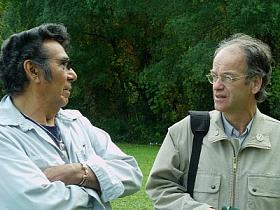First Nations investigate 50,000 missing children
Both pro- and anti-government groups in the Mohawk Nation united recently to endorse the independent investigation into mass graves of children at the former Mohawk Institute Indian residential school. The inquiry was initiated last April by nine elders of the Wolf and Turtle clans. Chief Bill Montour of the government-funded Mohawk Band Council said publicly at a council meeting on 2011 October 4: “This dig is long overdue and it’s needed. I back this thing one hundred percent.” Meanwhile, the Men’s Fire, a traditional group of warriors from all of the Six Nations, arrived at the excavation site the same day to provide security and protection for the inquiry members, especially for Kevin Annett of the ITCCS, who was asked by the Wolf and Turtle elders in writing to organize the inquiry into the missing children of the Brantford school. As a sign of their support for Kevin Annett and the ITCCS, these elders formally adopted Kevin into the Turtle Clan of the Mohawk (Ongyahonway) Nation at a ceremony on October 6, and gave him the name Rawennatshani, which means “One who warns the people with a strong and wise voice”. The inquiry into the fate of many hundreds of missing children at the school continued this week, through Ground Penetrating Radar surveys that revealed that graves of children on school grounds were buried under tons of soil; and that suspected grave sites extend into the wooded perimeter of the former school, which was founded by the Crown and Church of England in 1832. “We’re looking at a massive investigation into an enormous crime site, but at least it’s begun” commented Kevin Annett today. “We hope to have a preliminary report issued before the new year once we have samples and other evidence analyzed forensically. We’ve already assembled an archaeological team to do a professional study of what’s being uncovered.” Recently, traditional Mohawk elders announced that they were imposing their own jurisdiction over the graves of residential school children, and declared that the government of Canada, its police and courts had no authority to intervene into their investigation. Elsewhere in Canada, groups which include Maliseet and Anishnabe nations announced this week their intent to launch their own digs and inquiries at suspected mass grave sites at former residential schools on their territories, independently of the government’s stage-managed “Truth and Reconciliation Commission.” “The Mohawks have inspired all of us” said Jeremiah Jourdain of the Anishnabe nation in Winnipeg recently. “Now we have to spread this movement to bring the children home on our terms – and prosecute those who killed them.” Nearly half of all Canadian Indian residential school students – more than 50,000 children – died or went missing between 1832 and 1996, when the last school closed.
Comments
There are 0 comments on this post













